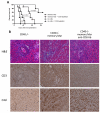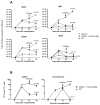CD40-independent help by memory CD4 T cells induces pathogenic alloantibody but does not lead to long-lasting humoral immunity
- PMID: 24102790
- PMCID: PMC4019209
- DOI: 10.1111/ajt.12432
CD40-independent help by memory CD4 T cells induces pathogenic alloantibody but does not lead to long-lasting humoral immunity
Abstract
CD40/CD154 interactions are essential for productive antibody responses to T-dependent antigens. Memory CD4 T cells express accelerated helper functions and are less dependent on costimulation when compared with naïve T cells. Here, we report that donor-reactive memory CD4 T cells can deliver help to CD40-deficient B cells and induce high titers of IgG alloantibodies that contribute to heart allograft rejection in CD40-/- heart recipients. While cognate interactions between memory helper T and B cells are crucial for CD40-independent help, this process is not accompanied by germinal center formation and occurs despite inducible costimulatory blockade. Consistent with the extrafollicular nature of T/B cell interactions, CD40-independent help fails to maintain stable levels of serum alloantibody and induce differentiation of long-lived plasma cells and memory B cells. In summary, our data suggest that while CD40-independent help by memory CD4 T cells is sufficient to induce high levels of pathogenic alloantibody, it does not sustain long-lasting anti-donor humoral immunity and B cell memory responses. This information may guide the future use of CD40/CD154 targeting therapies in transplant recipients containing donor-reactive memory T cells.
Keywords: Alloantibody; CD40 costimulation; memory T cells.
© Copyright 2013 The American Society of Transplantation and the American Society of Transplant Surgeons.
Figures






Similar articles
-
B cell activating factor (BAFF) and a proliferation inducing ligand (APRIL) mediate CD40-independent help by memory CD4 T cells.Am J Transplant. 2015 Feb;15(2):346-57. doi: 10.1111/ajt.12984. Epub 2014 Dec 12. Am J Transplant. 2015. PMID: 25496308 Free PMC article.
-
IFN-γ production by memory helper T cells is required for CD40-independent alloantibody responses.J Immunol. 2015 Feb 1;194(3):1347-56. doi: 10.4049/jimmunol.1401573. Epub 2014 Dec 29. J Immunol. 2015. PMID: 25548230 Free PMC article.
-
Memory alloreactive B cells and alloantibodies prevent anti-CD154-mediated allograft acceptance.J Immunol. 2009 Feb 1;182(3):1314-24. doi: 10.4049/jimmunol.182.3.1314. J Immunol. 2009. PMID: 19155477
-
CD40-CD40L Blockade: Update on Novel Investigational Therapeutics for Transplantation.Transplantation. 2023 Jul 1;107(7):1472-1481. doi: 10.1097/TP.0000000000004469. Epub 2023 Jun 20. Transplantation. 2023. PMID: 36584382 Free PMC article. Review.
-
Novel insights into anti-CD40/CD154 immunotherapy in transplant tolerance.Immunotherapy. 2015;7(4):399-410. doi: 10.2217/imt.15.1. Immunotherapy. 2015. PMID: 25917630 Free PMC article. Review.
Cited by
-
Mechanisms of antibody-mediated acute and chronic rejection of kidney allografts.Curr Opin Organ Transplant. 2016 Feb;21(1):7-14. doi: 10.1097/MOT.0000000000000262. Curr Opin Organ Transplant. 2016. PMID: 26575854 Free PMC article. Review.
-
Memory B cells and long-lived plasma cells in AMR.Ren Fail. 2022 Dec;44(1):1604-1614. doi: 10.1080/0886022X.2022.2128374. Ren Fail. 2022. PMID: 36190837 Free PMC article. Review.
-
Water channel aquaporin 4 is required for T cell receptor mediated lymphocyte activation.J Leukoc Biol. 2023 Jun 1;113(6):544-554. doi: 10.1093/jleuko/qiad010. J Leukoc Biol. 2023. PMID: 36805947 Free PMC article.
-
Measuring alloreactive B cell responses in transplant recipients.Curr Transplant Rep. 2019 Mar;6(1):99-105. Epub 2019 Jan 24. Curr Transplant Rep. 2019. PMID: 31588407 Free PMC article.
-
Desensitization in HLA-incompatible kidney transplant recipients: current strategies and emerging perspectives.Clin Kidney J. 2025 Jul 9;18(8):sfaf219. doi: 10.1093/ckj/sfaf219. eCollection 2025 Aug. Clin Kidney J. 2025. PMID: 40755969 Free PMC article. Review.
References
-
- Klein U, Dalla-Favera R. Germinal centres: role in B-cell physiology and malignancy. Nature reviews Immunology. 2008;8(1):22–33. - PubMed
-
- Sauve D, Baratin M, Leduc C, Bonin K, Daniel C. Alloantibody production is regulated by CD4+ T cells’ alloreactive pathway, rather than precursor frequency or Th1/Th2 differentiation. Am J Transplant. 2004;4(8):1237–1245. - PubMed
-
- Taylor AL, Negus SL, Negus M, Bolton EM, Bradley JA, Pettigrew GJ. Pathways of helper CD4 T cell allorecognition in generating alloantibody and CD8 T cell alloimmunity. Transplantation. 2007;83(7):931–937. - PubMed
Publication types
MeSH terms
Substances
Grants and funding
LinkOut - more resources
Full Text Sources
Other Literature Sources
Medical
Research Materials

